I was just a stupid joke... but If it is "our land" why aren't the Americans kicked out of there?You're asking Iranians to bomb our land, wtf are you on about? Some of you lot really lose your damn minds just to hate anything Western.
Latest Thread
You are using an out of date browser. It may not display this or other websites correctly.
You should upgrade or use an alternative browser.
You should upgrade or use an alternative browser.
Because we made an agreement with them lad, why is that so hard to understand? They aren't invading us, or taking that land from us with force. Like it or not, they are our allies right now, an ally that we not only have economic ties but also military ones, whether it is equipment or part purchases, like all important engines for example, or training together as apparently the case with these bomber coming here.I was just a stupid joke... but If it is "our land" why aren't the Americans kicked out of there?
Turkiye should strengthen its autonomy within NATO, but this should not be in progress as Russia's interests. Turkiye has shown that it will remain neutral on this issue and this actually more than enough. This tension is basically a familiar form of power game in the region that benefits both sides of the issue. Apart from that, the planned and routine activities of the Turkish armed forces within the NATO alliance are nobody's business.
Timing and public announcement of nuclear capable bombers is no coincidence. America knew these attacks from Iran will happen since they even attacked American bases successfully. America knew Iran wouldn't mind attacking Israel or Türkiye if provoked. Since Iran also is a nuclear power, now.I dont see anything wrong with the Lancers either, we're NATO, we will train with other NATO countries and their equipment.
Treacherous Americans are implying us as a target for Iran to attack instead of Israel on purpose. Iran several times said that she will attack with their unstoppable hypersonic missiles to bases in any and all nations that take part in an attack against Iran.
Not a single plane should be allowed to take flight until this crisis is over. They may take part in an attack against Iran by hiding their true mission.
I am also of the opinion that Turkey should not allow other countries to use its territory and skies to attack Iran. Probably everyone here remembers 2003. Washington has long asked Ankara to allow American troops to attack Iraq from Turkish territory. He even offered several billion for agreement. Turkiye refused.Timing and public announcement of nuclear capable bombers is no coincidence. America knew these attacks from Iran will happen since they even attacked American bases successfully. America knew Iran wouldn't mind attacking Israel or Türkiye if provoked. Since Iran also is a nuclear power, now.
Treacherous Americans are implying us as a target for Iran to attack instead of Israel on purpose. Iran several times said that she will attack with their unstoppable hypersonic missiles to bases in any and all nations that take part in an attack against Iran.
Not a single plane should be allowed to take flight until this crisis is over. They may take part in an attack against Iran by hiding their true mission.
Sooner or later, these currently powerful countries will leave the region, and Türkiye and Iran will remain neighbors. And enmity will remain between them for centuries. Neither Turkey nor Iran needs this.
Do you really think that any traffic can go outbound or inbound of/in Incirlik without the permission of the Turkish Armed Forces?Timing and public announcement of nuclear capable bombers is no coincidence. America knew these attacks from Iran will happen since they even attacked American bases successfully. America knew Iran wouldn't mind attacking Israel or Türkiye if provoked. Since Iran also is a nuclear power, now.
Treacherous Americans are implying us as a target for Iran to attack instead of Israel on purpose. Iran several times said that she will attack with their unstoppable hypersonic missiles to bases in any and all nations that take part in an attack against Iran.
Not a single plane should be allowed to take flight until this crisis is over. They may take part in an attack against Iran by hiding their true mission.
The Incirlik Airbase, otherwise known as the 10th Tanker Base Command which is tied to the Air Forces Combat Command is a Turkish airbase and Turkiye has full authority and ownership over it including all its facilities. The commander of the 10th Tanker Base is Air Pilot General Kemal GULEC (a Turkish officer). It is a Turkish Armed Forces airbase under the command of the Turkish Air Forces and not an US airbase as some people with questionable intensions say.
In result of the Economy and Defence agreement signed between the US and Turkiye on 29 Mart, 1980 some of the facilities are opened for joint exploitation with the US within the prospects of joint security measures.
Implying that the US Air Forces can conduct independent missions from this airbase without the knowledge of the Turkish command is an offence over the intellect and professional qualities of the Turkish officers stationed there!
Despite such attempts and ambitions the Turkish officers in the airbase always stood their ground and never allowed misuse of the authority that was given to the US Air Force in the facilities they were allowed to use including in critical moments for Turkiye as the "15th July" FETO treachery.
Other than that let me tell you something regarding the politics of Iran in the region and especially when it comes to Turkiye. Iran doesn't need US or NATO forces to be stationed in Turkiye in order to launch a comparable attack over Turkish civilian and militaray targets to what we saw in Israel. The mere existence of Turkish military units in Iraq and Syria is enough for this.
Mark my words!
In 5 years from now, when our military operations in Zap, the North of Iraq are completed, after we besiege Gara, mark the terrorist camp as militarily non-effective and effectively start to exert influence over Sinjar (a strategic red line for Iran), whatever you saw in Israel awaits our military bases on foreign soil in Iraq and Syria with the exception that we don't posses any air defence system to effectively counter these ballistic missiles and the countries that intervened in the case of Israel with tens of fighter jets, air defence systems and intelligence will show ZERO determination to help us deal with that threat. And when the Republic of Turkiye is forced to respond to these attacks within article 51 of the UN chapter for self defence and somehow a militia commander or an IRGC advisor is present within the targeted area and hit, then you will see what I am talking about. Border cities with population of 2-3 million people are all potential targets for the Axis of Resistance proxy forces and then may God help the Turkish Nation...
When our bases in the north of Iraq were attacked by Iranian militias not long ago and caused disturb among our ranks we only saw a small, "funny" trailer of what can happen to ALL our military bases in Syria and Iraq.
While they bring to an end the still sustainable stay of our military forces in these areas just think of what Iran can do to both our military installations in the region and our mainland. In times where Iran's Mullah leadership is acting like a mad man do you know what will be the only consideration for Iran in defence to NOT attack directly Turkiye and its mainland? The Article 5 of NATO and the NATO/US forces stationed in Turkiye and the region.
While we, the people with healthy minds know that Turkiye is the unwanted child in the family of NATO and don't expect any meaningful collective response from NATO when in need, Iran doesn't think this way because even if the relationship between Turkiye and NATO is a love and hate (more hate in recent times) relationship, there is still an obligation by the member countries to defend Turkiye. Let's say that NATO will not defend Turkiye in a possible conflict, but what IF? This IF is enough to constraint Iran from annihilating economically strategic cities like Ankara and turn our defence industry centers in Golbasi and Kirikkale into ashes. This IF would constraint Iran from annihilating major Turkish cities with tightly positioned population of 2-3-4-5 million people with its arsenal of hundreds, if not thousands of ballistic missiles by the time. Well, but we would respond... Yes! We will respond, but this will not bring back the already lost thousands of lives and billions of dollars. This may sound like the worst case scenario, but it is our duty to calculate this possibility and make everything possible for preventing this catastrophe.
We are very close to a rearrangement of power balances in the Middle East that will last for long time and we are very late to this game. Due to this fact we should keep a very hard balance between Iranian and US influence. We can't move even an inch without the security that US is giving us with just even its presence in the region! Sharks like Iran would eat our forces and spit them like it never was a thing. We still don't have the armed forces, the technologic maturity and the economy so we stay on our feet and only ambition is not enough. We are a rising regional power and nothing more. We need security and conditions so we can operate and big part of these security and conditions are there because the US is here. If US decides that it would pack its sh*t and go right now the focus of Iran and its allies will be us because Turkiye is the second factor present on the field that is preventing the Iranian mega project aiming at undisputed control from Iran, trough Baghdad, Sinjar, Syria and the Mediterranean. With our operations in the north of Iraq and Syria we not only prevent the PKK expansion supported by the US, but also the Iranian expansion that continues with the passive support of Russia and China. This is why we should keep them busy with each other while we are building our new reality in which every strategic move in our backyard by major actors like Iran or the US is done with the support and rightful share of and for Turkiye or simply abandoned!
Every major actor like the US and Iran is trying to build its own reality and balance that will solely benefit them without taking in account Turkiye. We must break this bad habit by reinforce our own independence (especially when it comes to the Armed Forces and defence industry) and prevent any major change in the dynamics of the region that would prevent us react and adapt on time, making it impossible to take the right posture and fill any power vacuum that has to be filled if needed. If we manage to get at least limited backing by a major power like the US till 2040, if we manage to survive as a unified State under one flag, if we manage to survive attacks to our sovereignty like the one we saw in the 15th of July event which posed an existential threat to the State and manage to keep and improve our armed forces deterrence and presence wherever we have interests in, then I am sure our future will be big, but till then we should not take a bite bigger than what we can get trough our throats, otherwise we are going to be eliminated from the race for a respected and valuable position within the New World Order. No matter how much we hate them and they hate us, they need us and we still need them. After 2040 this will be debatable, but for now the reality can make us all cry... Especially the ballistic missile, mad regime reality that is just across the border, bordering Azerbaijan and exerting control over the Caspian Sea.
If anyone wants to quote me on my geopolitical analysis, please quote me here:

Foreign Policy & Geopolitics
Let's talk about all that in a single thread that is easy to follow.
 defencehub.live
defencehub.live
The base is a nuclear base. Control of the nukes belong to America, despite co-ownership lies. There are even barbed wire to keep Turks out, inside our own base.
Turkish officers' have a tradition of betraying our nation with coups almost every ten years. It is not as rosey and under control as you pretend. Turkish Armed Forces you say is in charge couldn't do anything for almost a day while they were refueling F-16s from tankers of Incirlik bombing Turkish Parliament. It is not an insult, it is the bitter reality. Turkish armed forces have a thousand years history of mutinies, betrayals and cowardice too. It is not just bravery and sacrifice.
They took out nuclear ballistic missiles without asking us during Cuba crisis. They took out gravity bombs for “maintenance”, who knows if nukes are even real at this point. America doesn't need to store nukes in Incirlik at all. So chances are what we have there are just fakes after they returned the "nukes" from maintenance.
So no we are not in charge of Incirlik. Not 100%.
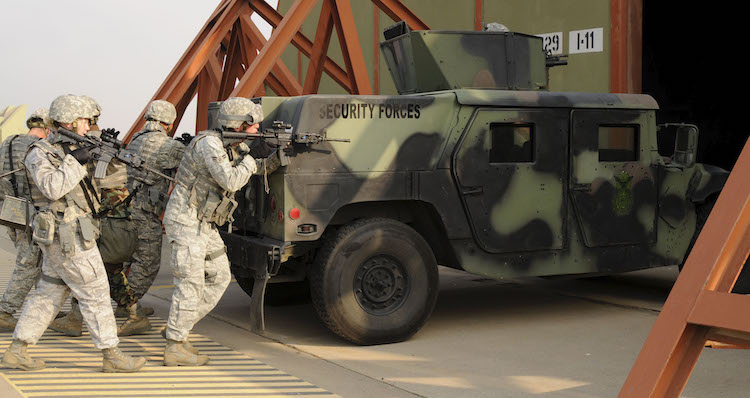
 fas.org
fas.org
Turkish officers' have a tradition of betraying our nation with coups almost every ten years. It is not as rosey and under control as you pretend. Turkish Armed Forces you say is in charge couldn't do anything for almost a day while they were refueling F-16s from tankers of Incirlik bombing Turkish Parliament. It is not an insult, it is the bitter reality. Turkish armed forces have a thousand years history of mutinies, betrayals and cowardice too. It is not just bravery and sacrifice.
They took out nuclear ballistic missiles without asking us during Cuba crisis. They took out gravity bombs for “maintenance”, who knows if nukes are even real at this point. America doesn't need to store nukes in Incirlik at all. So chances are what we have there are just fakes after they returned the "nukes" from maintenance.
So no we are not in charge of Incirlik. Not 100%.

Urgent: Move US Nuclear Weapons Out Of Turkey - Federation of American Scientists
Should the U.S. Air Force withdraw the roughly 50 B61 nuclear bombs it stores at the Incirlik Air Base in Turkey? The question has come to a head after Turkey’s invasion of Syria, Erdogan’s increasingly authoritarian leadership and deepening discord with NATO, Trump’s inability to manage U.S...
Last edited:
Who says that we were not in charge of Incirlik in the night of 15th of July? Show him to me so I can spit in his face.The base is a nuclear base. Control of the nukes belong to America, despite co-ownership lies. There are even barbed wire to keep Turks out, inside our own base.
Turkish officers' have a tradition of betraying our nation with coups almost every ten years. It is not as rosey and under control as you pretend. Turkish Armed Forces you say is in charge couldn't do anything for almost a day while they were refueling F-16s from tankers of Incirlik bombing Turkish Parliament. It is not an insult, it is the bitter reality. Turkish armed forces have a thousand years history of mutinies, betrayals and cowardice too. It is not just bravery and sacrifice.
They took out nuclear ballistic missiles without asking us during Cuba crisis. They took out gravity bombs for “maintenance”, who knows if nukes are even real at this point. America doesn't need to store nukes in Incirlik at all. So chances are what we have there are just fakes after they returned the "nukes" from maintenance.
So no we are not in charge of Incirlik. Not 100%.

Urgent: Move US Nuclear Weapons Out Of Turkey - Federation of American Scientists
Should the U.S. Air Force withdraw the roughly 50 B61 nuclear bombs it stores at the Incirlik Air Base in Turkey? The question has come to a head after Turkey’s invasion of Syria, Erdogan’s increasingly authoritarian leadership and deepening discord with NATO, Trump’s inability to manage U.S...fas.org
After the terrorists managed to get 3 tankers in the air by deceiving the personnel in the base do you know what happened? They wanted to get another one in the air and at least 3 F-16s, but were prevented. After the leader of the terrorists in Incirlik, Bekir Ercan was confronted by the Turkish soldiers that were in the base he took refugee in the same facility that the US is using and you are saying it is inaccessible to the Turkish Armed Forces. The Turkish soldiers then entered the facility by force, despite the opposition of the US personnel stationed there and in result Bekir Ercan was taken out of this facility and brought to justice later.
On the question of operating F-16s under the control of these terrorists I can tell you one thing. Despite the numerous warnings of honorary Turkish officers, the political leadership in cooperation with the terrorists continued to infiltrate FETO elements within the Armed Forces! What is the end of this? All of the military and civilian administrative facilities under the control of the Fethullah Terrorist Organization were regained within 1 night, the FETO terrorist organization being absolutely shattered, Turkiye starting its own way towards independence.
Don't you try to put the blame on the honorary Turkish officers by comparing them with the traitors and terrorists who wore the uniform of the Turkish Armed Forces in that night ever again without making a distinction! I warn you!
Another thing that I see obliged to say is that you are comparing apples to oranges. You are comparing a terrorist coup attempt with the aim of changing the regime in Turkiye which was made possible due to a 60 years process to a possible independent US military operation out of a sovereign country enabling the possible use of nuclear weapons against another sovereign country. Do you realize what would be the complications and consequences if such a thing happens? Do you even realize what kind of bullshit you are talking about? This is not Call of Duty!
Yes, Turkiye has its problems, but your comments are absolutely immature and bordering madness. Transferring nuclear weapons without the knowledge of the Turkish Armed Forces in or out of Turkiye is not possible. Taking off of nuclear weapons loaded US bombers from Incirlik so they attack another country without the green light of Turkiye is also not possible. This is not a movie! Nuclear weapons are not fireworks or candies and the needed mechanism for the control over such strategic assets is established between the US and Turkiye within certain boundaries which are reinforcing the trust between the two countries prioritizing maximum safety. In the moment when the established protocols are violated Turkiye will take the needed measures to ensure its national security and put an end to the US exploitation of the Incirlik airbase!
Turkiye is not the playground of nobody and if somebody tries to play, we will make him a belly dancer as we previously showed! Who do you think Turkiye is? The years of using Turkiye as a toy are over!
Angry Turk !!!
Contributor
Beautifully said, Brother. Next time, no warning. Just perma ban everyone who talks like a Traitor. Mercy is weakness.Who says that we were not in charge of Incirlik in the night of 15th of July? Show him to me so I can spit in his face.
After the terrorists managed to get 3 tankers in the air by deceiving the personnel in the base do you know what happened? They wanted to get another one in the air and at least 3 F-16s, but were prevented. After the leader of the terrorists in Incirlik, Bekir Ercan was confronted by the Turkish soldiers that were in the base he took refugee in the same facility that the US is using and you are saying it is inaccessible to the Turkish Armed Forces. The Turkish soldiers then entered the facility by force, despite the opposition of the US personnel stationed there and in result Bekir Ercan was taken out of this facility and brought to justice later.
On the question of operating F-16s under the control of these terrorists I can tell you one thing. Despite the numerous warnings of honorary Turkish officers, the political leadership in cooperation with the terrorists continued to infiltrate FETO elements within the Armed Forces! What is the end of this? All of the military and civilian administrative facilities under the control of the Fethullah Terrorist Organization were regained within 1 night, the FETO terrorist organization being absolutely shattered, Turkiye starting its own way towards independence.
Don't you try to put the blame on the honorary Turkish officers by comparing them with the traitors and terrorists who wore the uniform of the Turkish Armed Forces in that night ever again without making a distinction! I warn you!
Another thing that I see obliged to say is that you are comparing apples to oranges. You are comparing a terrorist coup attempt with the aim of changing the regime in Turkiye which was made possible due to a 60 years process to a possible independent US military operation out of a sovereign country enabling the possible use of nuclear weapons against another sovereign country. Do you realize what would be the complications and consequences if such a thing happens? Do you even realize what kind of bullshit you are talking about? This is not Call of Duty!
Yes, Turkiye has its problems, but your comments are absolutely immature and bordering madness. Transferring nuclear weapons without the knowledge of the Turkish Armed Forces in or out of Turkiye is not possible. Taking off of nuclear weapons loaded US bombers from Incirlik so they attack another country without the green light of Turkiye is also not possible. This is not a movie! Nuclear weapons are not fireworks or candies and the needed mechanism for the control over such strategic assets is established between the US and Turkiye within certain boundaries which are reinforcing the trust between the two countries prioritizing maximum safety. In the moment when the established protocols are violated Turkiye will take the needed measures to ensure its national security and put an end to the US exploitation of the Incirlik airbase!
Turkiye is not the playground of nobody and if somebody tries to play, we will make him a belly dancer as we previously showed! Who do you think Turkiye is? The years of using Turkiye as a toy are over!
Last edited:
I don't accuse anyone in treachery. I am just giving a friendly warning regarding the clear distinction between the Turkish soldier and a terrorist wearing the Turkish camouflage pattern infiltrated into the institution. This usage of words may have came in a result of a frustration and a state of mind. I don't know. We may agree or disagree on the other points, but this warning is important! This is also not a personal warning, but rather warning to every reader.Beautifully said, Brother. Next time no warning, just perma ban everyone who talks like a Traitor. Mercy is weakness.
Another point I want to make clear is that I am a moderator and not a perma ban machine. Nobody should feel threatened to defend his point of view in front of me or oppose my opinion on any matter as long as the arguments presented are within the lines of the forum rules. I promise that I won't abuse my positions in chase for personal vendettas. This is below my level and I think I proved this many times already.
Have fun!
Angry Turk !!!
Contributor
Give me mod rights, I clean this HouseAnother point I want to make clear is that I am a moderator and not a perma ban machine
If you must communicate by spitting like you say, spit on the faces of the tens thousands of coup plotters throughout Turkish history, traitors in the Turkish army. FETO wasn't the first won't be the last that turned the weapons and power trusted to them against the goverment and the nation. They are still inside Turkish Armed Forces today.
B-1B is not nuclear capable anymore. Only about half of B-2s and small number of B-52s are.Timing and public announcement of nuclear capable bombers is no coincidence.
The name of the 10th Tanker Base Command located in Incirlik/Adana has been changed to “10th Main Jet Base Command” in line with the needs of our Air Force.
18 April-10 May 2024 Al Dhafra Air Base/United Arab Emirates
3 F-16 aircraft and 53 personnel from our 181st Fleet Command are participating in the Desert Flag-9/2024 Exercise.
3 F-16 aircraft and 53 personnel from our 181st Fleet Command are participating in the Desert Flag-9/2024 Exercise.
In Germany, FDP is ok with it, SPD is neutral and the Greens are against it.Will Germany approve Türkiye's 40 Eurofighter request? Has attitude of Germans turned to positive?
What did Steinmeier say in Ankara?
Anybody knows?
That woman, the Foreign Minister, Annalena Baerbock, is part of the Greens, and is very against it.
They are trying to convince her.
Germans love shooting themselves in the foot. Could you imagine embargoing a country for using the defence weapons you sold them against their adversaries? Isn't that the point of buying weapons? To use them against your enemy?
Look at this graphic, literally destroying their civil and defense industries to be "morally superior". Then look at France, good for the French.
From 6.3% to 5.6%. And 7.2% to 11%. France is now a bigger exporter of weapons than Russia!
Last edited:
TURKISH TESTERS
- Aviation Features
- Turkish testers
18th October 2018
FEATURE
The demanding flight test requirements of the Turkish Air Force are met by 401 Filo, a specialist unit flying F-4s and F-16s from Eskişehir. Cem Doğut investigates its weapons trials work.
Flight test focus
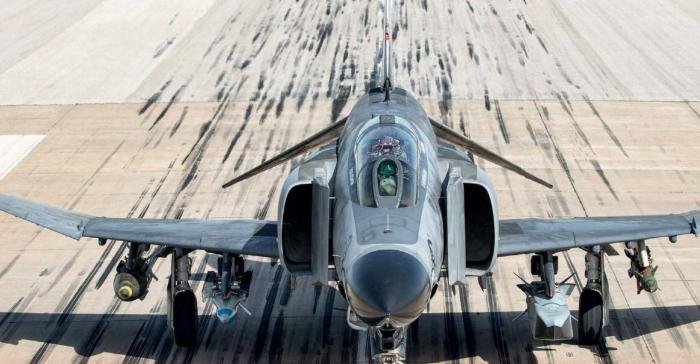
An F-4E 2020 assigned to 111 Filo and carrying (from left to right): HGK, KGK, SOM and LGK-82. The latter is an indigenous version of the 500lb GBU-12 laser-guided bomb.
All photos Cem Doğut
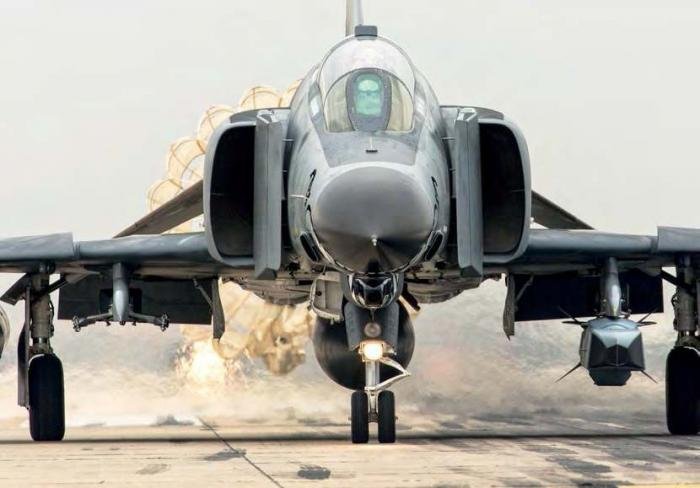
Return to base for a SOMarmed F-4E 2020. This powerful cruise missile weighs around 1,300lb of which the warhead accounts for approximately 500lb.
As one of the final operators of the Phantom, the Türk Hava Kuvvetleri (THK, Turkish Air Force) has embarked on successive programmes to extend the jets’ service life and increase capability. As long ago as August 24, 1995 an agreement was signed with the then Israel Aircraft Industries (IAI) covering structural and avionics work on 54 F-4Es. Of these aircraft, 26 were upgraded at IAI facilities and the rest at the 1. Hava İkmal Bakım Merkezi (1. HİBM, 1st Air Supply Maintenance Centre), in Eskişehir. After modernisation, the Phantom was redesignated as the F-4E 2020 Terminator. The project also established a system integration laboratory and an avionics testing and integration centre at the 1. HİBM. Today, these facilities form the basis of 401 Test Filo – the THK’s dedicated test and evaluation squadron.
In 2004, the 1. HİBM began the Işık (‘light’) programme that provided 18 RF-4Es with a structural and avionics upgrade. Modifications included the installation of an Aselsan LN-100GT integrated inertial navigation system (INS)/GPS, Rockwell Collins CDU- 900Z flight management system, AN/ALQ- 178(V)3 electronic countermeasures system and MXF-484 VHF/UHF radios. The THK’s last RF-4Es were retired in March 2015.
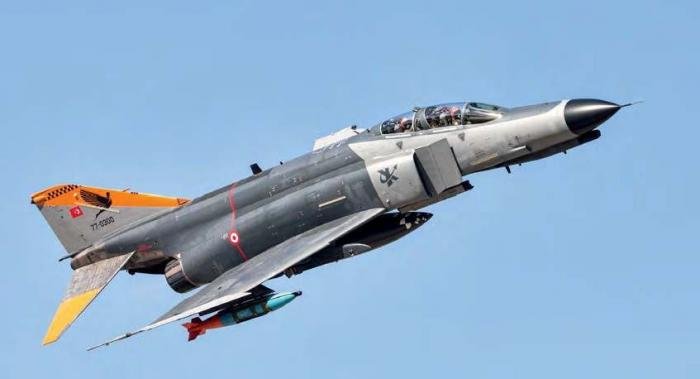
This 401 Test Filo Phantom is carrying an example of the HGK-LAB – a dual-guidance version of the HGK, combining laser and GPS/INS functions.
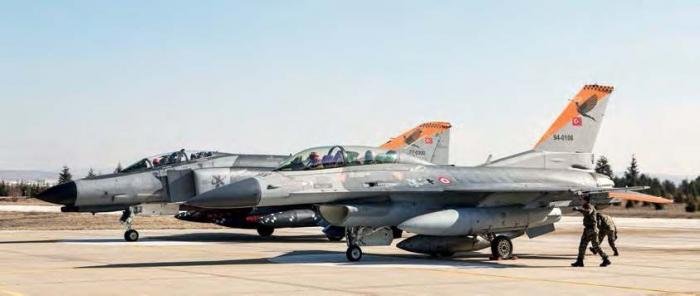
F-16D Block 50 94-0106 and F-4E 2020 77-0300 prepare to depart Eskişehir for a test mission. The Phantom carries examples of the HGK-3, a 500lb version of the HGK and underwing fuel tanks with calibration markings applied, while the ‘Viper’ will serve as a chase aircraft.
The Phantom upgrade projects combined with the Common Configuration Implementation Program (CCIP, pronounced ‘c-sip’) for the F-16C/D, provided the 1. HİBM with valuable avionics testing and integration experience. On April 17, 2013 the 401. Geliştirme Test Kıta Komutanlığı (401st Development Test Battalion Command) was established to ensure that this experience was preserved and built upon.
The THK test squadron, 401 Filo, was established within the Technology and Weapon System Development Command and has operated under the jurisdiction of Eskişehir’s 1st Air Supply Maintenance Centre Command since 1996. On March 13, 2015 it received the title 401 Test Filo Komutanlığı (401 Test Squadron Command). The unit flies F-4E 2020 and F-16C/D aircraft equipped for test work. After the July 15, 2016 coup attempt, 401 Test Filo was reassigned to Eskişehir’s 1. Ana Jet Üssü (1st Main Jet Base).
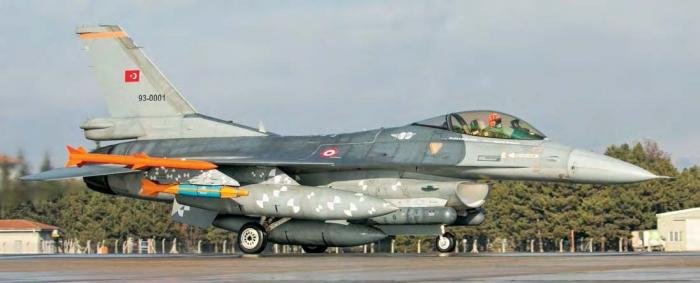
F-16C Block 40 93-0001 ‘bombed up’ with inert 500lb Mk82s fitted with the Roketsan TEBER modular low-cost guidance kit.
SOM
Among the major projects developed with assistance from the squadron is the Tübitak SAGE SOM (Stand-Off Missile) family of ‘fire and forget’ precision strike weapons, for use against land and sea targets. The SOM uses GPS as its primary mode of guidance complemented by an advanced INS and a radar-based terrain-referenced navigation system, allowing the missile to hug the terrain during flight to evade hostile air defence systems.
According to the manufacturer, the SOM features more advanced aerodynamics and a better configuration than similar missile systems, as well as lightweight composite components to minimise its radar cross-section. A terminal stage infrared (IR) imager detects the individual target by matching its signature with a pre-loaded database of similar targets. The seeker can also be used to provide imagebased mid-course navigation by gathering imagery of waypoints and comparing them against the predicted position to update the navigation system. In this way, if GPS capability is denied or degraded, the missile can follow its waypoints using IR-based terrain updates. The missile includes a twoway datalink to reassign targets in flight.
The SOM cruise missile made a first guided flight over the Black Sea on August 9, 2011. Covering more than 100nm using GPS/ INS guidance, the missile successfully hit its target with a high degree of accuracy. Around 30 test flights were scheduled to assess the SOM and a first batch of missiles had been delivered to the THK by the end of 2011.
The SOM is available in three variants for air force use:
• SOM A: Basic variant designed to engage a military target in simple strike mode using preplanned co-ordinates at the terminal stage
• SOM B1: Advanced variant that engages a military target in precision strike mode using imaging IR matching at the terminal stage
• SOM B2: Special variant with dualstage penetrator warhead to engage strategic and well-protected targets
Precision kits
Tübitak SAGE has also developed the HGK (Hassas Güdüm Kiti, precision guidance kit), a state-of-the-art GPS/INS guidance package that converts an existing 500lb (227kg) Mk82 ‘dumb’ bomb into a ‘smart’ weapon. Integrated GPS/INS guidance allows the HGK to hit a target with a circular error probable (CEP) of less than 20ft (6m) in all weather conditions. An INS-only mode provides the HGK with a CEP of less than 33ft (10m). HGK can reach a range of more than 12nm when released from medium altitude. A maximum range of 15nm is achieved after release from high altitude.
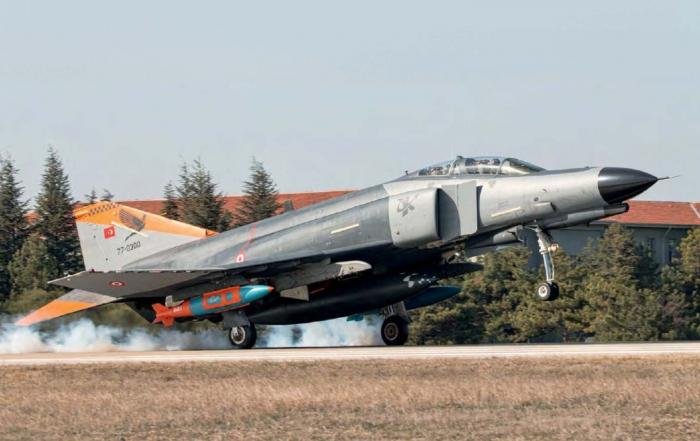
Phantom 77-0300 returns to base carrying an inert HGK test round. In future, Turkey plans to integrate the HGK – and the SOM cruise missile – on the F-35A.
ASELPOD
The Aselsan ASELPOD is another store that has been tested by 401 Test Filo. It weighs 518lb (235kg) and is 7.7ft (2.35m) long. The electro-optical and infrared (EO/IR) sensors can track up to eight targets at a laserdesignation range of a maximum 15.5 miles (25km) and a general range of up to 34 miles (55km). The pod can track moving vehicles such as main battle tanks at 9.3 miles (15km). The pod has a third-generation IR camera with a zoom function and uses a 640x512 pixel detector. The ASELPOD can perform day and night and can be used alongside laser-guided and INS/GPS precision-guided munitions. Development of the ASELPOD is ongoing and includes work on a twoway data link. This will enable the pod to double as an intelligence, surveillance and reconnaissance (ISR) asset in addition to its principal role as a targeting pod.
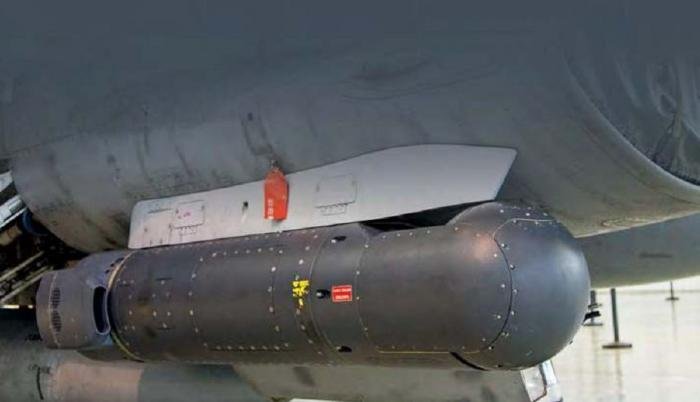
An ASELPOD on an F-16C’s right intake station. The pod is externally almost identical to the Rafael Litening.
The Roketsan TEBER is a modular low-cost guidance kit that can be fitted to 250lb (113kg) Mk81 and 500lb Mk82 general-purpose bombs. It converts the bombs into precision weapons using INS, GPS and an optional laser seeker. The laser seeker provides a capability against moving, relocatable and maritime targets, even if the objective is manoeuvring at high speeds. The CEP is below 10ft (3m) and the weapon has a range of 17 miles (28km).
Penetrating bomb
Tübitak SAGE’s NEB (Nüfuz Edici Bomba, penetrator bomb) is the first concretepenetrator system developed in Turkey and is designed to be used against surface and underground targets.
Penetrating bombs generally use one of two methods for penetration. First are those that provide penetration power using kinetic energy. The BLU-109, for example, has a 1in-thick (2.5cm) steel shell and is detonated by a delayed fuze in the tail. The kinetic energy must be high for the bomb to be effective. The second method makes use of a shaped charge warhead. In contrast, the NEB uses multiple warhead technology: an augmenting charge preceded by a follow-through bomb. It has similar external geometry, guidance unit interfaces, mass, centre of mass and inertia properties as the 2,000lb (907kg) Mk84 generalpurpose bomb, but offers high penetration performance even with low impact velocities and angles. An augmenting charge utilises preformed fragments for high fragmentation effect against surface targets and programmable fuze delay times mean it can be used against various target types. The NEB can be used with all guidance kits compatible with the Mk84 and can be dropped from all aircraft cleared to carry this bomb. Guidance options include the HGK and the GBU-10E/B laser guidance kit.
Wing kit
The Tübitak SAGE KGK (Kanatlı Güdüm Kiti, glide bomb kit) is a wing-assisted guidance kit that converts existing unguided 1,000lb (454kg) Mk83 and 500lb Mk82 generalpurpose bombs into long-range, air-to-ground smart weapons. The KGK employs the same guidance system as the HGK and can hit a target from a range of 62 miles (100km), in all weather conditions, allowing the launch aircraft to attack while avoiding enemy air defences.

Originally published in AirForces Monthly Magazine
In Germany, FDP is ok with it, SPD is neutral and the Greens are against it.
That woman, the Foreign Minister, Annalena Baerbock, is part of the Greens, and is very against it.
They are trying to convince her.
Germans love shooting themselves in the foot. Could you imagine embargoing a country for using the defence weapons you sold them against their adversaries? Isn't that the point of buying weapons? To use them against your enemy?
Look at this graphic, literally destroying their civil and defense industries to be "morally superior". Then look at France, good for the French.
From 6.3% to 5.6%. And 7.2% to 11%. France is now a bigger exporter of weapons than Russia!
View attachment 67691
Germans are taking L upon L.
The German ambassador of the West bank got kicked lmaooo
You had to see I think he was going to do a talk at a university all the Palestinians went up in arms and kicked him out.
Now dont forget how Nicragua has taken them to court.







